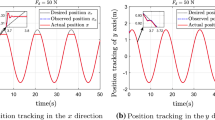Abstract
A controller design strategy of dual-arm robots is proposed in this paper. The controller consists of a central controller and three force controllers. The central controller is used to calculate each arm’s force command according to the desired object motion. A force controller is used in each arm to track the commanding force. Another force controller is used to track the desired contact force between the manipulated object and its environment. The force controller can be partitioned into three parts. The computed torque method is used to linearize and decouple the dynamics of a manipulator. An impedance controller is then added to regulate the mechanical impedance between the manipulator and its environment. In order to track a reference force signal, an on-line neural network is used to compensate the effect of unknown parameters of the manipulator and environment. The simulation results are reported to show the performance of the neural network compensator.
Similar content being viewed by others
References
Luh, J. Y. S. and Zheng, Y. F.: Constrained relations between two coordinated industrial robots for motion control, Int. J. Robotics Res. 6(3) (1987), 60–70.
Dauchez, P., Delebarre, X., Bouffard, Y., and Degoulange, E.: Task modeling and force control for a two-arm robots, IEEE Conference on Robotics and Automation(1991).
Yoshikawa, T. and Zheng, X.: Coordinated dynamics hybrid position/force control for multiple robot manipulators handing one constrained object, Int. J. Robotics Res. 12(3) (1993), 219–230.
Seraji, H.: Coordinated adaptive position/force control of dual-arm robots, Int. J. Robots and Automation 3(3) (1988), 140–149.
Schneider, S. A. and Cannon, R. H.: Object impedance control for cooperative manipulation: Theory and experimental results, IEEE Trans. Robotics and Automation 8(3) (1992), 383–394.
Jean, J. H. and Fu, L. C.: An adaptive control scheme for coordinated multimanipulator systems, IEEE Trans. Robotics and Automation 9(2) (1993), 226–231.
Backes, P. G.: Dual-arm supervisory and shared control task description and execution, Robotics and Autonomous Systems 12(1994), 29–54.
Lin, S. T. and Yae, K. H.: Identification of unknown payload and environmental parameters for robot compliant motion, in Proceeding American Control Conference, 1992, pp. 2952–2956.
Narendra, K. S. and Parthasarathy, K.: Identification and control of dynamic systems using neural network, IEEE Transaction on Neural Network 1(1990), 4–27.
Barto, A. G., Sutton, R. S., and Anderson, C. W.: Neuron-like adaptive elements that can solve difficult learning control problems, IEEE Transaction on System, Man, and Cybernetics SMC-13(1983), 834–846.
Franklin, J. A.: Reinforcement of robot motor skills through reinforcement learning, in Proceeding IEEE Conference on Decision and Control,1988, pp. 1096–1101.
Psaltis, D., Sideris, A., and Yamamura, A. A.: A multi-layered neural network controller, IEEE Control System Magazine1988, 17–20.
Kawato, M.: Computational schemes and neural network models for formation and control of multijoint arm trajectory, Neural Networks for Control, MIT Press, 1990.
Okuma, S., Ishiguro, A., Furuhashi, T., and Uchikawa, Y.: A neural network compensator for uncertainties of robot manipulators, in Proceedings IEEE Conference on Decision and Control, 1990, pp. 3303–3307.
Lin, S. T. and Lee, J. S.: Impedance control with on-line neural network compensator for robot contact tasks, J. Intell. Robotic Sys. 15(1996), 389–399.
Fukuda, T., Kurihara, T., Shibata, T., Tokita, M., and Mitsuoka, T.: Application of neural network-based servo controller to position, force, and stabbing control by robotic manipulators, JSME Int. J. Series III 34(2) (1991), 303–309.
Fukuda, T., Shibata, T., Tokita, M., and Mitsuoka, T.: Neuromophic control: application and learning, IEEE Trans. Ind. Electronics 39(6) (1992), 21–36.
Craig, J. J.: Introduction to Robotics, 2nd edn, Addison-Wesley, 1994.
Zurada, J. M.: Introduction to Artificial Neural Systems, West Info Access, Singapore, 1992.
Liu, S. H.: The application of neural network on heuristic learning control system, MS Thesis, The National Chung-Hsing University, Taichung, Taiwan, 1994.
Yun, X.: Object handling using two arms without grasping, Int. J. Robotics Res. 12(1) (1993), 99–106.
Author information
Authors and Affiliations
Rights and permissions
About this article
Cite this article
Lin, ST., Tsai, HC. Impedance Control with On-Line Neural Network Compensator for Dual-Arm Robots. Journal of Intelligent and Robotic Systems 18, 87–104 (1997). https://doi.org/10.1023/A:1007992700881
Issue Date:
DOI: https://doi.org/10.1023/A:1007992700881




